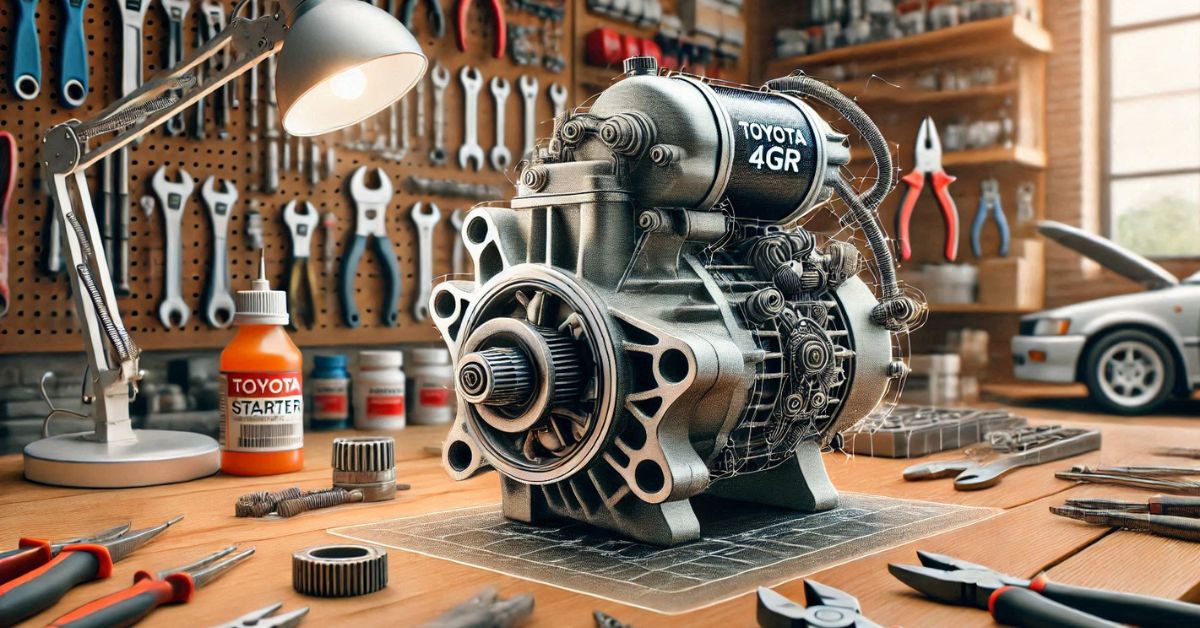The Toyota 4GR starter plays a vital role in ensuring the reliable performance of vehicles equipped with the 4GR-FSE engine. This starter motor is responsible for initiating the engine’s operation, converting electrical energy from the battery into mechanical energy to crank the engine. In this article, we’ll explore the key aspects of the Toyota 4GR starter, including its functions, common issues, troubleshooting tips, and maintenance advice.
What is the Toyota 4GR Starter?
The starter motor is an essential component of the ignition system in vehicles powered by the Toyota 4GR-FSE engine. This engine is a 2.5-liter V6 from Toyota’s GR family, known for its balance of performance and efficiency. The starter motor ensures that the engine starts reliably whenever the ignition key or button is engaged.
Key Features of the Toyota 4GR Starter
- Compatibility: Specifically designed to work seamlessly with the 4GR-FSE engine.
- Durability: Made from high-quality materials to withstand repeated use over the lifespan of the vehicle.
- Reliability: Engineered for consistent performance under various conditions.
Functions of the Starter Motor
The starter motor’s primary role is to crank the engine to initiate the combustion process. Here’s how it works:
- Activation: When you turn the key or press the ignition button, the starter relay sends an electrical signal to the starter motor.
- Engagement: The motor’s solenoid engages the pinion gear with the engine’s flywheel.
- Cranking: The motor spins the flywheel, which, in turn, rotates the engine’s crankshaft.
- Ignition: Once the engine reaches the required speed, fuel combustion takes over, and the starter disengages.
Common Issues with the Toyota 4GR Starter
Despite its durability, the 4GR starter can experience wear and tear over time. Here are some of the most common problems:
1. Failure to Start
- Symptoms: Clicking sound or no response when the ignition is engaged.
- Causes:
- Worn-out brushes inside the starter.
- Faulty solenoid.
- Corroded or loose electrical connections.
2. Slow Cranking
- Symptoms: Engine cranks sluggishly or struggles to start.
- Causes:
- Weak or failing battery.
- Damaged starter motor components.
- Corrosion on battery terminals or cables.
3. Intermittent Operation
- Symptoms: Starter motor works inconsistently.
- Causes:
- Internal wiring issues.
- Faulty starter relay.
- Problems with the ignition switch.
Diagnosing Starter Issues
If your Toyota 4GR-equipped vehicle is having trouble starting, follow these diagnostic steps:
- Check the Battery
- Ensure the battery is fully charged.
- Test the voltage with a multimeter (should read around 12.6 volts).
- Inspect Connections
- Look for corrosion or loose connections at the battery terminals and starter motor.
- Clean and tighten any affected connections.
- Test the Starter Relay
- Swap the starter relay with a similar one in the fuse box to rule out relay failure.
- Listen for Sounds
- A clicking noise often indicates a problem with the solenoid or insufficient power reaching the starter.
- Visual Inspection
- Inspect the starter motor for physical damage or signs of wear.
Replacing the Toyota 4GR Starter
If your diagnostic tests confirm that the starter motor is faulty, replacement may be necessary. Here’s a general guide:
Tools and Materials Needed
- Socket set and wrenches.
- Jack and jack stands.
- New starter motor (compatible with the 4GR-FSE engine).
- Safety gloves and goggles.
Steps to Replace the Starter
- Disconnect the Battery
- Remove the negative terminal to prevent electrical shorts.
- Locate the Starter
- The starter motor is typically located near the bottom of the engine, where it connects to the transmission housing.
- Remove the Old Starter
- Disconnect the wiring harness and unbolt the starter from its mounting bracket.
- Carefully remove the old starter motor.
- Install the New Starter
- Position the new starter motor and secure it with bolts.
- Reconnect the wiring harness.
- Reconnect the Battery
- Attach the negative terminal and test the new starter by starting the engine.
Maintenance Tips for Longevity
To ensure your Toyota 4GR starter lasts as long as possible, follow these maintenance tips:
- Keep Electrical Connections Clean
- Regularly inspect and clean the battery terminals and starter connections to prevent corrosion.
- Monitor Battery Health
- A weak battery can put extra strain on the starter motor. Replace the battery as needed.
- Address Issues Promptly
- Don’t ignore signs of starter trouble. Early repairs can prevent further damage.
- Perform Regular Inspections
- Check the starter motor for wear and tear during routine maintenance.
Conclusion
The Toyota 4GR starter is a critical component of the ignition system in vehicles with the 4GR-FSE engine. While generally reliable, it can experience issues due to wear or electrical problems. Regular maintenance and prompt repairs can help ensure its longevity and performance. If replacement becomes necessary, using a high-quality, compatible starter motor will restore your vehicle’s reliability.
By understanding the functions, troubleshooting steps, and maintenance tips for the Toyota 4GR starter, you can keep your vehicle running smoothly for years to come.

